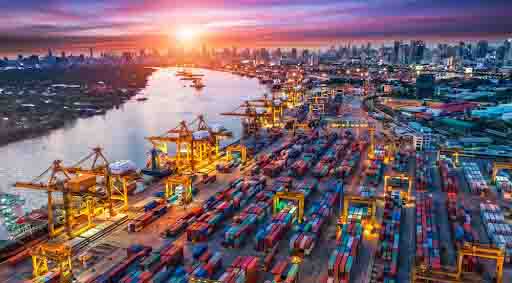By Wasana Nadeeshani Sellahewa
(Commonwealth) _ The Indian economy is the fifth biggest in the world, with a goal of reaching $5 trillion by 2025. One of the major drivers of this growth is likely to be the rise of India’s logistics industry, which employs 22 million people and serves as the backbone for several businesses. Investing in infrastructure development, such as dedicated freight corridors, enhancing road, rail, and maritime connections, and allowing technology-driven solutions for enhanced visibility across the supply chain, will be vital if India is to accelerate and sustain GDP growth.
The logistics sector in India was valued at $250 billion in 2021, with the market expected to expand to an outstanding $380 billion by 2025, at a robust 10%-12% year on year growth rate. However, the ecosystem is still grappling with several issues, with India ranked 44th in the World Bank’s Logistics Performance Index (LPI) and industry observers agreeing that logistics costs must be reduced. The cost of logistics in India is about 12%-13% of GDP, which is significantly higher than in BRICS nations or the US and Germany, which are around 11%, 9.5%, and 8%, respectively. To improve corporate efficiency, the government has already proposed many initiatives to reduce this figure to 8% by 2030.
Expectations for the Union Budget of 2023 revolve around the implementation of measures made as part of PM Modi’s National Logistics Policy (NLP), which he introduced in September 2022. The NLP will develop a single-window e-logistics market and encourage the smooth movement of goods across the country, with the goal of boosting economic growth, expanding employment, and improving the competitiveness of domestic products in local markets and overseas.
Following the Gati Shakti National Master Plan, which intends to immediately enhance first and last-mile connectivity, which continues to be a bottleneck for e-commerce firms and MSMEs across the board, this was a natural next step. With the unorganized sector accounting for more than 90% of the logistics business, there is a need for more cohesive communication among diverse stakeholders. As defined by the Unified Logistics Interface Platform, a technology-driven framework may bridge the gap between manufacturers, government organizations, customs, shippers, and service providers by facilitating information sharing in a safe, confidential, and real-time or near-real-time way (ULIP.)
The introduction of ULIP will be a game changer in the future, increasing logistical visibility, reducing costly delays and transportation expenses, and increasing corporate efficiency. Furthermore, Indian entrepreneurs will play an important role in the strengthening and acceptance of this open-source protocol to break down silos of communication, boost standardisation and service quality evaluation, and increase automation for improved dependability and convenience of doing business. Better warehousing, cold storage facilities, and improved first and last mile connections are also required to eliminate waste and encourage faster delivery of commodities from port to port, city to city, and state to state.
With nearly 60% of all freight in India moved by road (compared to the world average of 25%), our motorways are the lifeline for commodities movement. Furthermore, programs such as FASTag are assisting in reducing trucking and transportation times. However, the sector anticipates a push in the Union Budget for the establishment of Dedicated Freight Corridors (DFC) and multi-modal logistics parks with air freight terminals and increased rail links for more efficient trading across state boundaries.
There is also the possibility of encouraging players to use electric vehicle (EV) infrastructure for business purposes in order to improve last-mile delivery services while minimizing the industry’s carbon impact. While the government has already indicated many ambitious plans to accelerate growth and unlock opportunities in this business-critical sector, expectations from the Union Budget 2023 center on practical, implementable steps to accelerate India’s vision of reducing logistics costs in India to single digits by 2030 in order to become more competitive on the global stage.








